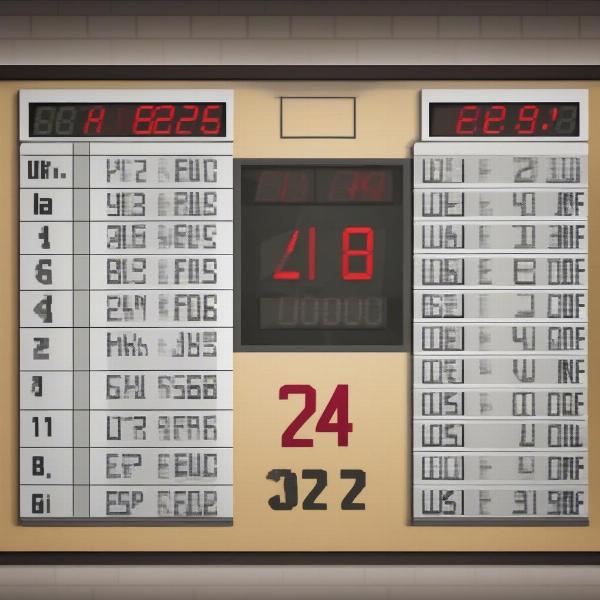Volleyball terminology can be confusing for newcomers. One common question is the difference between a volleyball game and a match. While often used interchangeably, there’s a distinct difference. This article will delve into the specifics, clarifying when to use each term and exploring other related vocabulary to help you become more fluent in the language of volleyball.
After reading this article, you’ll confidently distinguish between games and matches, and you’ll be well on your way to understanding the nuances of this exciting sport. You’ll be able to follow along with commentators, understand the rules more clearly, and even impress your friends with your newfound volleyball vocabulary. So let’s dive in!
Decoding “Game” vs. “Match” in Volleyball
The difference between a game and a match boils down to scope. A game is a single unit of play within a larger match. Think of it as one round of competition. The first team to reach a certain number of points, typically 25 with a two-point advantage, wins the game.
A match, on the other hand, consists of multiple games. Most professional and collegiate volleyball matches are best-of-five sets, meaning the first team to win three games wins the match. High school matches are often best-of-three. Therefore, a match is the overall contest, comprised of several individual games. It’s the bigger picture. Think of a game as a chapter, and the match as the entire book.
So, if someone asks you, “Is it a volleyball game or match?”, you can confidently explain the difference. A game is a part of a match; a match is the whole competition.
 Volleyball Game Point Action
Volleyball Game Point Action
How Many Games are in a Volleyball Match?
As mentioned earlier, the number of games in a match varies depending on the level of play. In professional and collegiate volleyball, matches are typically best-of-five, requiring a team to win three games to secure the match victory. High school and some other amateur levels often play best-of-three matches, where winning two games is sufficient for the win.
Understanding this distinction is crucial for following the flow of a match. Knowing that a team needs to win three out of five possible games gives you a better perspective on the significance of each individual game. For instance, losing the first game in a best-of-five scenario isn’t as detrimental as losing the first game in a best-of-three.
Other Important Volleyball Terms
While understanding the difference between “game” and “match” is essential, knowing other volleyball terms will enhance your understanding and appreciation of the sport. Here are a few key terms to add to your vocabulary:
- Set: Another term for “game.” The terms “set” and “game” are interchangeable. You might hear commentators use either term.
- Rally: A sequence of plays, starting with the serve and ending when the ball is out of play.
- Dig: A defensive move where a player prevents the ball from hitting the floor after an attack from the opposing team.
- Spike: An offensive move where a player hits the ball with force downwards towards the opponent’s court.
- Block: A defensive move where players at the net jump and extend their arms to try to deflect an opponent’s attack.
Familiarizing yourself with these terms will allow you to follow the action more closely and understand the strategies employed by the teams. Just like learning the difference between a game and a match, understanding these other terms will give you a deeper understanding of volleyball.
Understanding Scoring in Volleyball
Now that we’ve covered the difference between games and matches, let’s discuss how scoring works within a volleyball game. As mentioned earlier, a team generally needs 25 points to win a game, with a two-point lead required. For example, if the score is 24-24, the game continues until one team establishes a two-point advantage.
This scoring system adds an element of suspense and excitement to the game. Close games can be particularly thrilling, with teams battling back and forth to gain that crucial two-point lead. Understanding the scoring system helps you appreciate the intensity of those close contests.
 Volleyball Scoreboard Close Game
Volleyball Scoreboard Close Game
Knowing how scoring works in conjunction with understanding the structure of games and matches adds another layer to your overall understanding of volleyball.
Volleyball Set Strategies and Tactics
Similar to is it a volleyball game or match, understanding the strategic nuances of sets (or games) within a volleyball match is vital. Teams often employ different strategies depending on the stage of the match. For example, a team might conserve its best players’ energy early in a best-of-five match, knowing they have more games to play. Conversely, in a best-of-three match, every game is crucial, so teams might be more aggressive from the start. Coaches also analyze opponents’ weaknesses and adjust their team’s strategies accordingly, such as focusing attacks on a weaker blocker or serving towards a less skilled receiver. The dynamics of the game shift constantly, demanding quick thinking and adaptability from both players and coaches.
The Evolution of Volleyball Rules
Volleyball, like many sports, has seen its rules evolve over time. Early versions of the game had different scoring systems, net heights, and even the number of players on the court. Understanding how the rules have changed provides context for the modern game. These changes have often been driven by the desire to make the sport more dynamic, spectator-friendly, and fair.
The Importance of Teamwork in Volleyball
Volleyball is fundamentally a team sport. Success relies on effective communication, coordinated movements, and a shared understanding of the game plan. While individual skills are essential, teamwork is what elevates a group of talented players into a cohesive and successful unit. Just as understanding the difference between a game and a match requires recognizing the interconnected parts within the whole, effective teamwork in volleyball necessitates recognizing the importance of each player’s contribution to the team’s overall success.
Conclusion
So, is it a volleyball game or match? Hopefully, this article has cleared up any confusion. Remember, a game is a single unit within the larger context of a match. Whether you’re watching a professional match or playing a casual game with friends, understanding this distinction adds to your enjoyment and appreciation of the sport. Keep learning, keep playing, and keep enjoying the exciting world of volleyball! Share this article with fellow volleyball enthusiasts to help them understand the difference between a game and a match.
FAQ
- What is the difference between a set and a game in volleyball? There is no difference. The terms “set” and “game” are used interchangeably in volleyball.
- How long does a volleyball match typically last? A match can last anywhere from an hour to over two hours, depending on the number of sets and the closeness of the scores.
- How many points are needed to win a volleyball game? Typically, 25 points are needed to win a game, with a two-point lead required.
- What is a rally in volleyball? A rally is a sequence of plays that starts with the serve and ends when the ball is out of play.
- What does “match point” mean? Match point is the final point needed to win the match.
- What is a libero in volleyball? A libero is a specialized defensive player with unique rules regarding their substitutions and playing actions.
- Where can I find more information about volleyball rules and terminology? Numerous online resources, including the official FIVB website, offer comprehensive information about volleyball.
Just as you now understand the difference between a game and match, learning about topics like what was the score of the cu game can further enhance your understanding of specific volleyball events and competitions.

